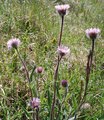860715 Erigeron borealis (Vierh.) Simmons
Distribution
Northern Iceland: Frequent
Northern Fennoscandia: Scattered
Kanin - Pechora: Frequent
Polar Ural - Novaya Zemlya: Scattered
Yamal - Gydan: Rare
Taimyr - Severnaya Zemlya: Rare
Southern Arcti Tundra: Rare
Shrub Tundra: Frequent
Bordering boreal or alpine areas: Frequent
- Simmons, Acta Univ. Lund., n. s., sect. 2, 9, 19: 127 (1913). - Trimorpha borealis Vierh., Beih. Bot. Centralbl. 19, 2: 447 (1906). Described from Scandinavia.
2n=
18 (2x). - Europe (N), Russia (N), Siberia. - Several reports, numerous counts.
Geography: European (N) - Asian (NW): ICE NOR RUS SIB.
Notes: Elven and Solstad: The comparatively late description (1906) of the widespread Erigeron borealis is due to difficulties in its polymorphy and its delimitation from two or more species described much earlier from the Alps: E. alpinus L., Sp. Pl.: 864 (1753) and E. neglectus A. Kern., Oesterr. Bot. Z. 21: 253 (1871). Halliday (1976a) did not refer very good differential characters between E. alpinus, E. borealis, and E. neglectus. He mainly stated that the basal leaves of E. alpinus have dense crispate hairs, those of E. borealis are sparsely pubescent, and those of E. neglectus ciliate. Huber and Nilsson (1995) compared Nordic and Alpine plants but did not reach any satisfying conclusion.
At least two fairly distinct morphological types occur within what currently is considered as E. borealis in the North Atlantic regions: one in coastal northern Norway and perhaps Scotland and Greenland (see E. alpiniformis above) and one in Iceland, mountain parts of Fennoscandia, and northern European Russia. The gap between the Fennoscandian part of its range (including the Khibiny Mountains in the Murman area) and the northeastern European Russian one might indicate some additional complexity. Halliday (1976a) stated E. borealis to be intermediate between the central Europeans E. alpinus and E. neglectus and that "it might perhaps best be treated as a subspecies". Ö. Nilsson (in comment) proposed that the northern coastal plant in Fennoscandia could belong within E. neglectus. Further study is needed before we know whether E. borealis is one or several plants and how it or they relate to the Alpine and Greenland plants.
We have recently checked Icelandic material (ICEL) assigned to E. borealis and find it to conform to Scandinavian mountain E. borealis rather than to Greenlandic E. alpiniformis or coastal North Norwegian E. borealis. We cannot exclude that E. alpiniformis occurs in Scandinavia, as part of the evident polymorphy in E. borealis s. lat. in that region. The trimorph flowers of E. borealis are easily observed in fresh material but much more difficult to decide in herbarium specimens. A fine and woolly involucre pubescence, reported for E. alpiniformis, characterizes many coastal Norwegian populations.
-

Erigeron borealis (de:Nordisches Berufkraut) in Iceland
Source: JuTa at Wikispecies
Higher Taxa
- Erigeron [8607,genus]